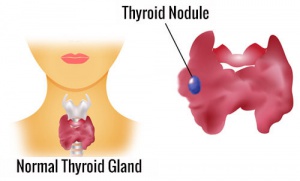How to Know if a Lump is Benign or Malignant

The thyroid nodules are made up of cells that grow right around the thyroid glands. They might grow in such a way that they form a lump or several lumps in the front part of the neck. These can either be benign or malignant.
More women than men are affected by this disease. The issue affects up to five percent of women, but only one percent of men. Also, the risk of getting it increases with age. These nodules, or lumps, can be detected by touching or seeing them. Nevertheless, many times they aren’t caught and go unseen. It’s very important to be aware of any change in your body.

Also Read: Home Remedy to Promote Thyroid Health
If you discover anything abnormal, whether you see it or feel it in the front of your neck, it’s important to consult an endocrinologist as soon as possible. They will tell you if it is necessary to do some specialized tests, like a thyroid sonogram, to check if the nodules are benign or not. The endocrinologist will then be able to tell you about the necessary treatment. Also, if you know early on what type of lumps they are, you’ll enjoy peace of mind. Thyroid nodules can be:
- Cystic – these contain liquid.
- Solid – these are formed mainly by cellular matter.
- They can be a mixture of the previous two.
How can one tell if a lump is malignant?
The structure of the lump doesn’t matter in determining whether it’s malignant. According to the American Thyroid Association, nine out of ten cases are benign. The most effective way of identifying if the lesions are benign or malignant is with a sonogram. During this test, a procedure is done with a very thin needle being inserted and puncturing the suspicious nodule area.
See Also: Thyroid Conditions – Is Everything Working Well?
The most reliable results come from puncturing the nodule or nodules during the sonogram. That allows the doctor to examine the sample taken from the nodule. If the cytologist finds the sample taken inadequate, they can redo the process at the same time until any suspicions are gone. This procedure isn’t painful and doesn’t require anesthesia. The work of both the radiologist and the cytologist allow them to offer you a definite diagnosis that the endocrinologist who requested the test must immediately review. Only then will they be able to start the appropriate treatment.

Always be alert
Remember to not overlook any abnormal symptom or lump you notice. If you know each and every one of the spots on your body and you check them once in a while in the mirror, you’ll definitely discover any hardness that’s forming. You’ll then be in a good position to go see a specialist so they can tell you whether you have a problem or not. This is a very effective way to prevent serious diseases because. That’s because if there’s a risk of contracting a disease that has a malignant origin and it is detected on time, the chances of eradicating it will be much greater.
All cited sources were thoroughly reviewed by our team to ensure their quality, reliability, currency, and validity. The bibliography of this article was considered reliable and of academic or scientific accuracy.
- Moubayed, S. P., & Urken, M. L. (2016). Thyroid nodules. CMAJ. https://doi.org/10.1503/cmaj.160300
- Elaraj, D. M. (2010). Evaluation of the thyroid nodule. Cancer Treatment and Research. https://doi.org/10.1007/978-1-4419-0857-5_2
- Kamran, S. C., Marqusee, E., Kim, M. I., Frates, M. C., Ritner, J., Peters, H., … Alexander, E. K. (2013). Thyroid nodule size and prediction of cancer. Journal of Clinical Endocrinology and Metabolism. https://doi.org/10.1210/jc.2012-2968
This text is provided for informational purposes only and does not replace consultation with a professional. If in doubt, consult your specialist.








